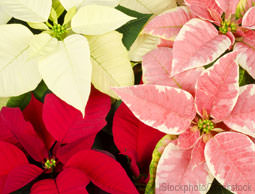
 Courtesy iStockphoto/Thinkstock Poinsettia bracts (i.e., their colorful leaves) come in scarlet, pink, ivory and mauve. |
When images of the holidays dance across your mind, chances are poinsettias are in the picture. Not just a plant for Christmastime, poinsettias are the best selling potted plant in the United States, with 34.7 million plants being produced in 2011 alone. Unfortunately, popularity doesn’t always guarantee survival.
Poinsettias can last for years if they are treated right, says Paul Thomas, professor of horticulture at the University of Georgia College of Agricultural and Environmental Sciences. Unfortunately, come February or March, many of these cheery decorative Christmas gifts are droopy, yellowed or worse—in the trash.
But all is not lost for these festive plants. To have the best chance of surviving past the holidays, poinsettias need to be healthy and strong before you bring them home. Thomas recommends purchasing poinsettias from a local florist or nursery to get the best quality plants. Inspect the poinsettia to ensure it has strong, sturdy stems, dense foliage down the length of its stems; that its bracts (i.e., the colored leaves) have no blemishes; and its small, yellow flowers have just barely opened. Also carefully remove the poinsettia from its pot to inspect the plant’s root system. Don’t buy it if it has just a few roots or a lot of dark brown roots—healthy poinsettias have plentiful, tan and white roots.
Holiday Poinsettia Care
Poinsettias come in several colors, including scarlet, ivory, pink and mauve. The colorful part that we might consider the poinsettia flower is actually a collection of colored leaves, called bracts. The plants true flower is the tiny yellow bloom in the middle of the bract, called a cyathium.
Poinsettias are susceptible to root rot, so don’t overwater or let them sit in water-logged saucers. The holiday foil that florists wrap around some poinsettia pots can trap water, so it’s best to remove it. Only water when the soil surface feels dry, and irrigate until water drains out of the bottom of the pot.
Because poinsettias are native to Mexico, they prefer at least six hours per day of bright light and temperatures between 65 and 70 degrees F. However, they can spend a few weeks on a fireplace hearth or in the shade of a Christmas tree with proper care.
According to Thomas, overwatering and fertilizing holiday poinsettias are the most common causes of death.
“During the holidays, you can place poinsettias just about anywhere to liven things up,” he says. “They’ll last about three weeks in fairly dark places. While it’s in the dark, water only when the soil is dry. And don’t fertilize it.”
Year-round Poinsettia Care
After you put away the tree and find places for your gifts, move your poinsettia to a sunny window and apply a small amount of houseplant fertilizer.
“The bracts may begin to fall off fast,” Thomas says. “This is normal. If they last until March, your poinsettia was very happy where you put it.”
In April, cut the plant back to about 10 inches or until there are four to six nodes of the stem above the soil.
“At this point, the poinsettia can be grown outdoors in full sun,” Thomas says. “If watered and fertilized, poinsettias will grow great outdoors. Trim them in June and plant them in 1-gallon pots or large indoor planters.”
An outdoor poinsettia needs to be fertilized every week with a basic houseplant fertilizer during the spring and summer. Try a natural fertilizer with an NPK ration of 15-0-15, 15-16-17 or 20-10-20.
“If watered and fertilized properly, poinsettias will grow quite large, as high and wide as 5 feet,” Thomas says.
To force your repotted poinsettia to bloom, cover the plant after 6 p.m. starting at the onset of fall (the end of September), and uncover it at 7 a.m. Do this for about three weeks. This process will trigger the poinsettia to make new colorful bracts and flowers just in time for the holidays.




